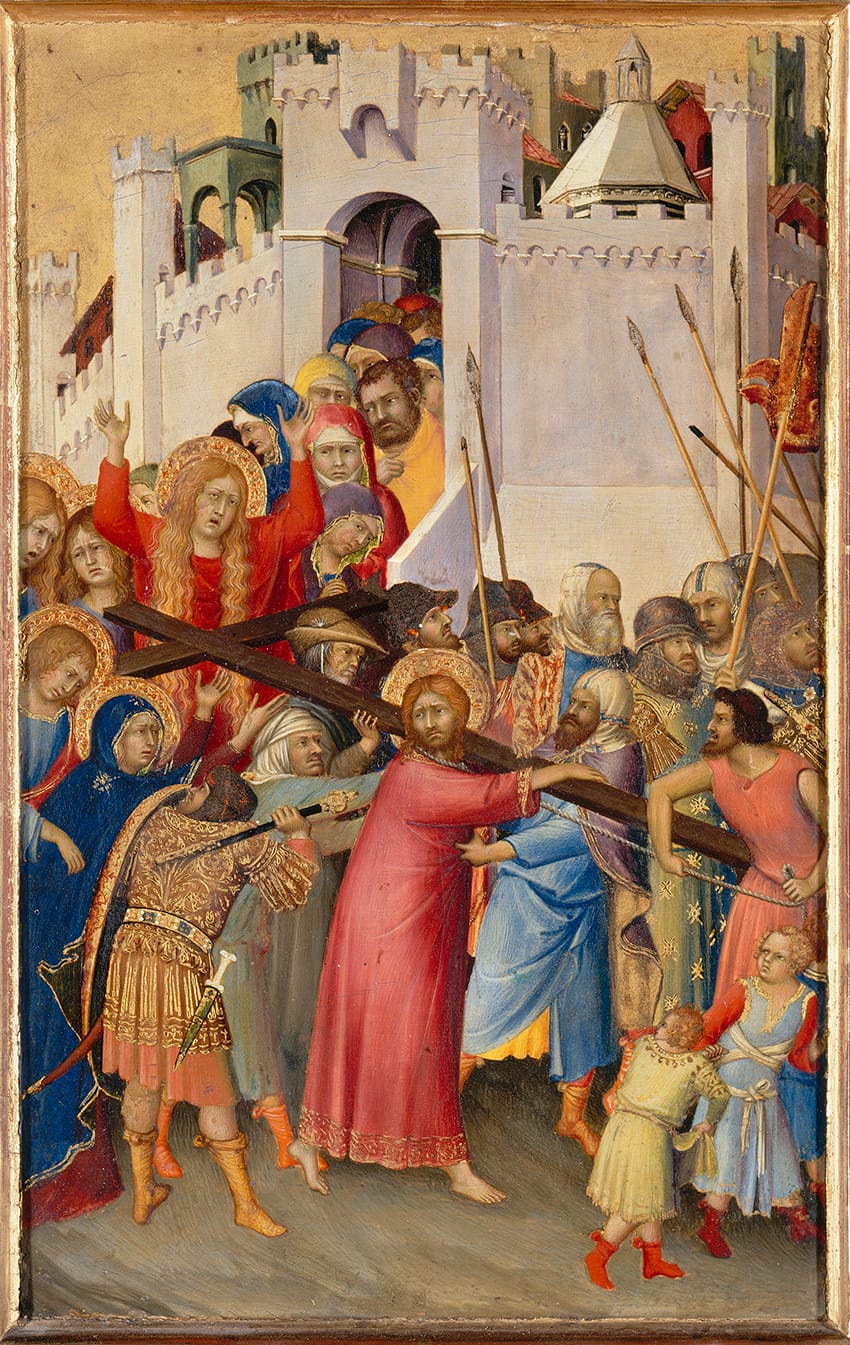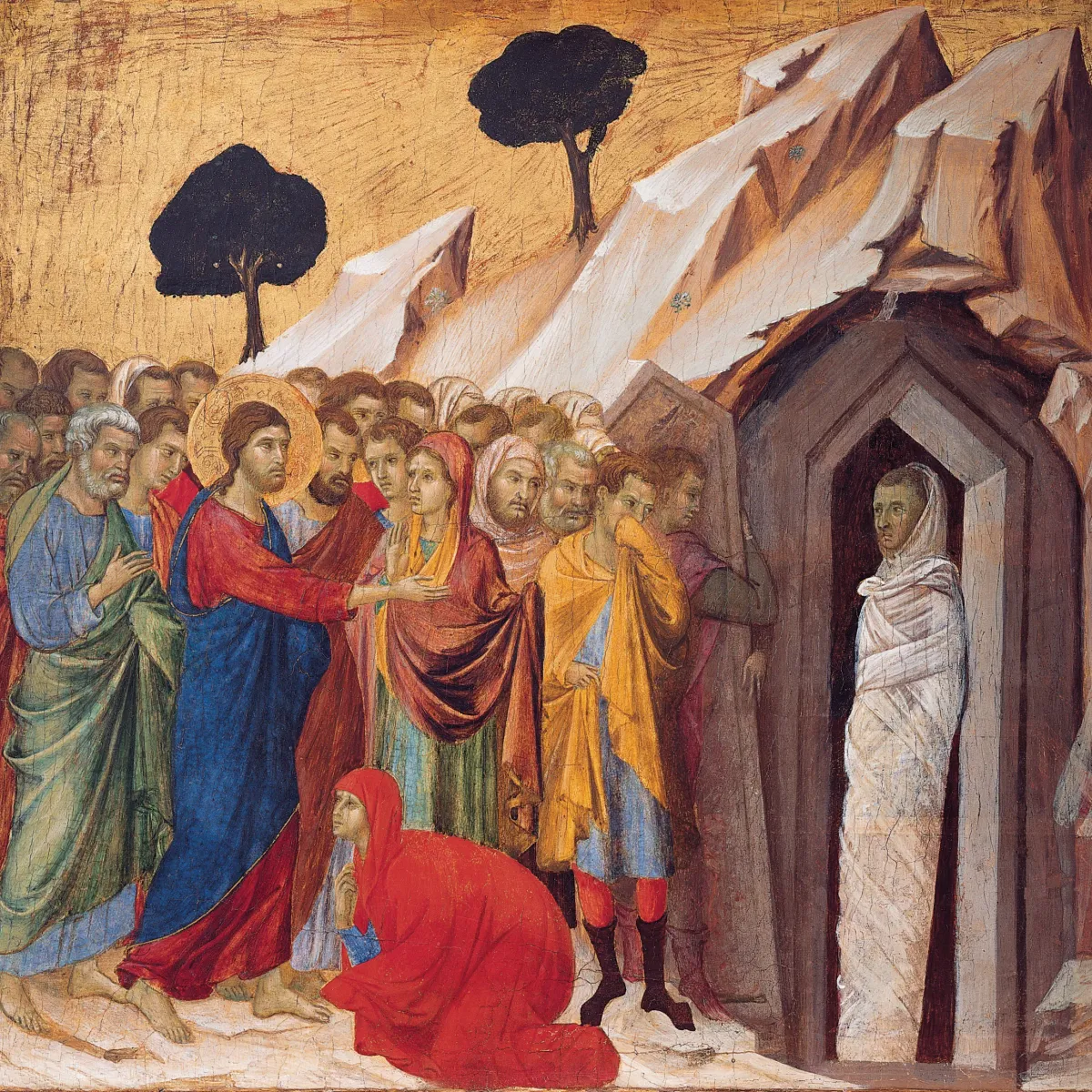What makes the flat, trippy, colorblocked paintings of the Sienese Renaissance so suited to our strange present? They’re miles from the High Renaissance we know well – Michelangelo’s fleshy bodies, Boticelli’s whimsical, drifting women, Raphael’s flawless Madonnas. You could call them surrealist, and easily compare them to the flatness of modernist painting. You could also call them Byzantine, and place them in a Middle Eastern visual inheritance. Like so many European paintings, they set Biblical stories in the recognisable streets and landscapes of their painter’s hometowns. Jesus and Mary Magdalene process by the terracotta pink plaster walls and red tile roofs of Tuscany, easy for viewers to imagine as fellow citizens.
Why haven’t most of us seen these paintings before? Why aren’t they part of the story of the Renaissance we are told? Siena is a strange little medieval time capsule – a city frozen at what turned out to be its peak, of both population and cultural and political power. Siena is a story of the path history didn’t take. It was decimated by the plague in 1348, losing a full 50% of its population, and then conquered by Florence a century later, ending its golden era as a democratic republic city state. Its history feels exceptionally poetic to me, but it has particular relevance in our current moment of macro post-pandemic socio political upheaval. Who will write our history? We can see the machinations of storytelling in real time; we can watch the powerful work to ensure that their version is the one that is remembered.

I lived in Siena in 2016, and it has never released me from its spell. The quiet, sturdy, winding streets, the half-finished cathedral that was abandoned after the plague, the fountains in each of the sixteen contradas in which each baby born to a resident are still baptised – there is something about this place that embodies the passage of time and the resilience of place. It’s become a cult-y destination for in-the-know travellers; Hisham Matar’s beautiful reflection on spending time there, A Month in Siena, articulates many of the qualities that keep me returning again and again, too.
Siena’s paintings, and their relative obscurity, are beacons of the instability of history. The reason we don’t know these works, and the reason we know Michelangelo and Botticelli and the other iconic names instead, is largely because of the ‘first’ art historian: the Florentine Giorgio Vasari, who wrote The Lives of the Artists in the 1550s, as Florence was consolidating power over Siena. His selection of the most important artists (mostly from Florence) defined taste in Renaissance and Baroque Europe, and then in the centuries after, as taste circled back to the Renaissance over and over, just as it circles back to antiquity. And that selection was guided by his assumptions, conscious and unconscious, about power. Why would he choose to highlight Sienese artists, when they had just been conquered?
“We think of stories…as this kind of side issue that our enemies use to distract people away from more material concerns. But that’s exactly backwards,” Ta-Nehisi Coates said in an interview recently. He talked about the way the populist right has gained power around the world, particularly in America, by telling powerful stories. “History is not inert but contains within it a story that implies or justifies political order,” he writes in his latest book, The Message. We get swept up in the narratives of those who tell us they have answers. Stories are everything. The people who tell them best dominate, describing to us what we think is the truth.
Renaissance Florence was one of the birthplaces of capitalism. In his writing, Vasari referred regularly to the idea of “competition” amongst artists fueling their rapid innovations, and it guided his opinion of them. The rivalrous, gladiatorial nature of competing for capital did promote aggressive self-promotion and rapid progress in artistic style and virtuosity. But it foreshadows the destructive path capitalism would eventually carve. That the seeds of neoliberalism undergird the dominant narrative of the Renaissance itself is no accident – art and politics have always been intertwined.
The consequences of whether we remember Florentine or Sienese artists who lived over half a millennia ago might seem small, but they are not. Firstly, they are not because the art of the Italian Renaissance has had an outsize influence on the trajectory of Western art, visual culture, and social values. We continue to be guided by the implications of depictions of race and gender, by architectural methods of flexing power, by the ideas of beauty and religion they communicate to us. Secondly, they are not small because any story of domination and erasure has consequences, and the recognition – the memory – of these acts is usually hard to find. When we talk about the Italian Renaissance, we do not talk about how Siena is irrelevant. It is simply not part of the narrative – we talk about Florence and Rome instead. That is the privilege of the powerful: to write something out of memory. And so our rehabilitation of those erased narratives is always important, and always political. Narratives create myths – the myths of nations, of religions, of power.
When we look at these paintings now, it’s easy to think they look bad. The gold might seem gaudy, the perspective false and incorrect, the flatness due to lack of skill. We live in a post-Raphael world (much to the chagrin of the Victorian Pre-Raphaelite Brotherhood). We cannot unsee the invention of single-point perspective or the use of shadow and colour to create modeling. We cannot let go of our expectation that historical figurative painting should be lifelike, representative of reality. We have a narrative of the evolution of art, from the “Dark Ages” through the innovations of the Renaissance and then through the dawn of Modernism and the ascent up the mountain of abstraction.
But Sienese painters were not working in that linear narrative. They lived on a great highway, a pilgrimage route from Canterbury to Rome, and they were exposed to an international melee of travellers moving through Siena. Their paintings incorporated ideas from Gothic France, from Constantinople, even tartan patterns from Scotland. They used an advanced cocktail of visual styles to create an aesthetic that told the stories they wanted to tell.
In Duccio’s Annunciation, it is not a failure of the artist that the figures appear as if they are moving on a stage set. The carefully contained architecture of pink and grey walls encapsulates the narrative moment in the painting, showing us how to read it. The archangel Gabriel enters from a golden nothingness, descending into the mortal world to tell Mary that she will bear the son of god. The arched space around Mary demarcates her from the angel, and the dark doorway behind her marks her way back to the physical realm. Above her, the ceiling is brown – she is not yet in heaven, like the angel, who will rise back up into the gold above him. These geometric, simple ways of telling the viewer who these figures are and how they are different make it easy for anyone to look at this image and understand what is happening: an angel and a human woman are meeting on a single plane, and something profound and important passes between them. It’s purpose is twofold – first, to tell a story, and second, to foster faith and the solace it can provide.
An exhibition at the National Gallery in London (previously at the Met in New York) currently brings together many of the major works from Siena’s Renaissance. It doesn’t really answer the questions I’ve raised here about why we don’t know these works or what they offer us – or at least, doesn’t really reflect on why it should matter. Seeing so many works in the same space drives home their visual coherence and power, but also the profound way in which artistic taste in Europe pivoted away from this tradition. The way taste evolves to follow power – both political and social – is the historical legacy of Siena’s hidden Renaissance, and should be the lens through which we reflect on their relevance today.
In the current context of state-driven erasure of history by the Trump administration in the United States, it has never been more imperative that we take seriously the lessons of what-might-have-beens like Siena in the history of art and taste. Forgetting about Siena doesn’t feel like it has the same stakes as erasing diversity and difficulty from American museums and classrooms, and it certainly doesn’t right now. But narratives like this one should remind us of the same thing Ta-Nehisi Coates is trying to remind us: that the stories of power are written by the arts.

